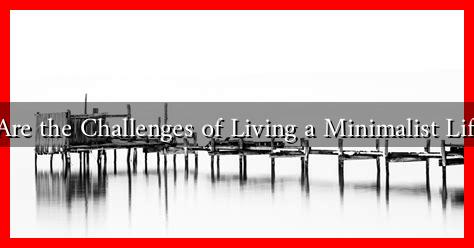-
Table of Contents
What Are the Challenges of Living a Minimalist Lifestyle?
Minimalism has gained significant traction in recent years, with many individuals seeking to simplify their lives by reducing clutter and focusing on what truly matters. While the benefits of a minimalist lifestyle are often highlighted—such as reduced stress, increased financial freedom, and enhanced focus—there are also several challenges that individuals may face when adopting this lifestyle. This article explores these challenges in depth, providing insights and examples to help you navigate the complexities of minimalism.
Understanding Minimalism
Before delving into the challenges, it’s essential to understand what minimalism entails. At its core, minimalism is about intentionally choosing to live with less. This can apply to physical possessions, commitments, and even relationships. The goal is to create space for what truly matters, whether that be experiences, relationships, or personal growth.
Common Challenges of Minimalist Living
While the allure of minimalism is strong, the journey can be fraught with obstacles. Here are some of the most common challenges faced by those who choose to embrace a minimalist lifestyle:
- Emotional Attachment to Possessions: Many people struggle to let go of items that hold sentimental value. For instance, a family heirloom may evoke cherished memories, making it difficult to part with, even if it serves no practical purpose.
- Social Pressure and Expectations: Society often equates success with material wealth. Friends and family may not understand your minimalist choices, leading to feelings of isolation or judgment.
- Fear of Missing Out (FOMO): In a consumer-driven culture, the fear of missing out on experiences or possessions can be overwhelming. This can lead to a cycle of acquiring items that contradict minimalist principles.
- Time and Effort Required for Decluttering: Transitioning to a minimalist lifestyle often requires significant time and effort to declutter. This process can be physically and emotionally exhausting, especially for those with a lot of possessions.
- Maintaining Minimalism: Once you’ve decluttered, the challenge shifts to maintaining a minimalist lifestyle. This requires ongoing vigilance against the accumulation of new items and commitments.
Case Studies: Real-Life Experiences
To illustrate these challenges, consider the following case studies:
- Sarah’s Sentimental Struggle: Sarah inherited a collection of vintage clothing from her grandmother. While she loves the pieces, they take up significant space in her closet. The emotional attachment makes it difficult for her to let go, even though she rarely wears them.
- Mark’s Social Dilemma: Mark decided to downsize his living space and possessions. However, his friends often invite him to events that require more formal attire, which he no longer owns. This has led to feelings of exclusion and frustration.
Statistics on Minimalism
Research supports the notion that minimalism can lead to a more fulfilling life, but it also highlights the challenges:
- A survey by the Statista Research Department found that 78% of respondents felt overwhelmed by their possessions.
- According to a study published in the Journal of Consumer Research, individuals who practice minimalism report higher levels of life satisfaction, but 65% also noted difficulties in maintaining their minimalist lifestyle.
Strategies for Overcoming Minimalist Challenges
While the challenges of minimalism can be daunting, there are strategies to help overcome them:
- Set Clear Goals: Define what minimalism means to you and set specific, achievable goals for decluttering.
- Practice Mindfulness: Engage in mindfulness practices to help you detach from emotional attachments to possessions.
- Communicate with Loved Ones: Share your minimalist journey with friends and family to foster understanding and support.
- Start Small: Begin with one area of your home or one category of items to avoid feeling overwhelmed.
Conclusion
Living a minimalist lifestyle can be incredibly rewarding, but it is not without its challenges. From emotional attachments to societal pressures, the journey requires introspection and commitment. By understanding these challenges and employing effective strategies, individuals can navigate the complexities of minimalism and ultimately create a life that aligns with their values and priorities. Embracing minimalism is not just about reducing physical clutter; it’s about making room for what truly matters in life.

